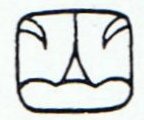|
TRANSLATIONS
The sign at the top of the head (being the eye) in some Zotz glyphs probably is a variant of the night sign in Akbal:   Yet they are opposite in the same way as these H glyphs are in opposition to those in Q:
The central sign in Akbal is a triangular 'mountain', while in the same Zotz location a round figure is seen. Probably the triangular sign in Akbal refers to the moon, while in Zotz the round figure refers to the sun. In Akbal two moon crescents are balancing at a full moon sign, I think. In Zotz the round halfcircle is at the bottom of what could be a stylized tree - designed to allude to the triangular full moon sign in Akbal. Sun at bottom also indicates night. "In verbs the major line of distinction is not the personal one of active or passive, but the practical one of the transitive of intransitive; it is the doing something special, resultful, that makes the line - a quality which also underlies the Indian's well-known 'taciturnity'. He is not therein just surly by nature; by mental bent he uses the words, or part of words, necessary; and then stops. The same in nouns: the thing possessed is not distinguished from that not possessed, but the thing applied to use is distinguished. This fact is marked all through Mayance languages by the most common of all word-terminations, the final -l, usually preceded by the stem vowel. This denotes the concrete specialization, practicalization, of the thing - or idea-in-itself behind what is seen or felt operating. Akbal is, in fact, a case in point; it is the darkness of the night which we feel or see, and which presses on our senses, affecting and changing our activities. It is not the night, but its manifestations, its darkness. The Indian is fully believing, indeed ever-conscious of 'things within and behind'; but he also sees their effects, and the things without, directly eye-to-thing, and carries that into his actions and speech." (Gates) What then is the '-ness' in Canal? Gates has three more examples of Zotz glyphs (with numerical signs - 3, 4, and 8 - in front):  The 'night eyes' are all different in the details, but we can imagine the same message: the bat eye can see in the night. The sign of night is appropriate not only for the month Zotz, but also for the two following months, Tzec and Xul:
I guess the season is the first quarter of the year before sun light has 'lifted the sky high'. Notice how in Xul the 'sun pupil' has lifted a little, though. The preceding season probably is new year time:
We can now understand that the 'knot' in Pop not only illustrates the 'mat' of the Moon Goddess and the 'binding of the years', but also the 'bars' preventing sun light to enter. The little 'yellow' quincunx (top right in Pop) is foremost, maybe representing the new 'fire'. In Uo the upper register apparently may illustrate the darkness below the sky roof, with two small white 'teeth' in the center. In Tzec (the central month of the three in the same way as Uo is central in the first triad of months) the 'teeth' are higher up. The twin night 'fangs' in Akbal and in the 2nd triad of months perhaps reflect the twin 'teeth', in which case the 'fangs' ought to represent the moon and the 'teeth' the sun. Though, like egg and hen it is difficult to determine which came first. We can put the first Maya months in parallel with the 'planets' in the order of our week:
Next comes Jupiter, and we now expect Tzec to show signs corresponding to that planet. |
||||||||||||||||||||||||||||||||||||||||








